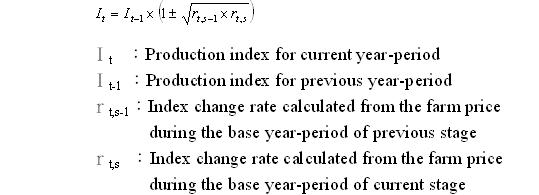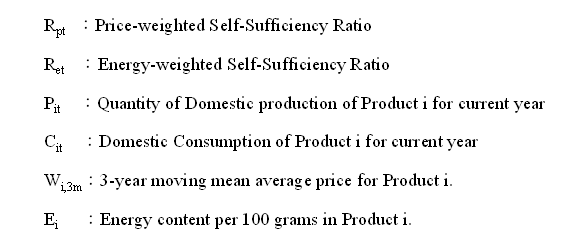Balance Sheets Methods of Preparing Taiwan Food Balances Sheets
I.Principle and Methods of Food Balance Sheet Compilation
1) Amounts of Domestic Production: This comprises amounts of primary commodity and processed or derived products which are made in Taiwan by using imported raw materials, e.g. soybean oil made from imported soybean is included in the amounts of domestic production of soybean oil. Unless otherwise indicated, production amounts of primary commodity of agricultural, fishery and livestock products, in principle, are estimated in accordance with the data published by the “Agricultural Statistics Yearbook’’ .
2) Changes of Stock: This comprises changes or differences between closing stocks and opening stocks. An increase (+) in stock of a commodity during the reference period (year) means a reduction in the availability for domestic supply (and thus domestic utilization). On the contrary, a decrease (-) in stock indicates a release of stock and an increase (+) in the domestic supply available of the reference year.
3) International Trade: This covers the amounts of imports and exports. Relevant data are, in principle, obtained from the export & import statistics published by the customs administration. For agricultural products and processed commodities, they are first converted into raw materials before being aggregated or added up to total estimate. Those clearly inedible portion or non-food products (e.g. feed milk fed to animals, industrial oil/fats and seeds for reproduction purposes) are not included in the element/column “Amounts of Imports and Exports” of Food Balance Sheets.
4) Amounts of Domestic Supply: This is computed by the following equation:
Amounts of Domestic Supply=Amounts of Domestic Production + Amounts of Imports - Amounts of Exports Changes in Stock.
5) Amounts of Feed Utilization: This comprises the amounts of commodity in question for domestic supply, which are fed to livestock during the reference period.
6) Amounts of Seed Utilization: This represents the amounts of all the commodities in question of domestic supply, which are used during the reference period for reproduction purposes. The amounts of seed utilization of a specific crop can be first estimated by multiplying the quantity of seed utilization of the crop with the area in hectare under the crop plantation during the reference year, and then followed by the deduction of the amounts of imported seeds. Since the amounts of poultry and fishing production is devoid of portion used for reproduction purposes, the amounts of seed utilization are not computed.
7) Amounts of Processed Food Utilization: This covers the amounts of domestic supply which are used for the following two purposes:
1.Non-Food (inedible portion of food) Manufacture: This refers to the amounts of commodity in question used during the reference period for manufacturing processed commodities for non-food purposes, e.g. starch for bond or glue or oil/fat for soap.
2.Food (edible portion) Manufacture: This covers the amounts of commodity in question used during the reference period for manufacturing processed food commodities for which separate entries are provided in the food Balance Sheets in the same or in another food group (e.g. seed or oil seeds used for vegetable oil by extraction process).
8) Amount of Waste/Loss: This comprises the amounts of commodity in question wasted or lost at all stages between the level at which production is recorded and the retail shop, i.e. the waste or loss and thrown-way taking place in the household, e.g. in the kitchen, is excluded.
9) Amounts of Food Supply (Gross): This represents the balance derived from the following equation:
Domestic Supply - (Food Utilization + Seed Utilization + Food Manufacture/Processing Utilization + Waste/Loss) = Amounts of Gross Food Supply
10) Extraction Rate: This is to express the input/output ratio between originating/parent commodity and manufactured/processed commodity in terms of percentage and applies mainly to manufactured food or processed commodities for human consumption (e.g. the milling process of paddy rice to milled rice, wheat grains to floor, cassava to starch). In addition, for some commodities containing husks or other inedible part, the extraction rate can also be adopted to effect a conversion to calculate the amount of food (net) supply for human consumption purposes.
11) Amounts of Food Supply (Net): This represents the actual amounts of food directly available for human consumption, which are computed by multiplying corresponding figures in the food (gross) supply column with those in the extraction ratio column. For those commodities to which the extraction rate is not applicable, the amount of food (net) supply equals the amount of food (gross) supply.
12) Per Caput Food (net) Supply: Under this column, estimates are provided for per caput food (net) supplies available for human consumption during the reference period which are expressed in terms of quantity in two ways: (1) in kilogram per year per person; and (2) in gram per day per person. The data for (1) per caput per year are obtained from dividing the amounts of total food (net) supplies available for human consumption by the total population in Taiwan at mid-year point of the reference year. The data for (2) per caput per day are calculated by dividing the quantity of per caput food (net) supply per year by the total days (365) of the reference year.
13) Per Caput Total Nutritive Value per Day: The nutritive value (e.g. caloric value, protein and fat content) per caput food (net) supplies can be obtained by multiplying per caput food (net) supplies per day for each commodity of various food groups with the appropriate food composition or nutritive factors of the specific food group (e.g. water content, variety, and the degree of milling for wheat flour). All the aggregate food nutritional composition factors are obtained on the basis of annual weighted average computed according to food consumption coverage/content year by year. Data on nutritional composition factors of a specific product or commodity of a food group are mainly obtained from “A Database for Taiwan Area Food Nutritive Composition Factors” complied and published by the Department of Health of the Executive Yuan and complemented by relevant data collected from the testing reports submitted by those academic institutes commissioned by the COA and consulted with other relevant sources from home and abroad.
14) Population at Mid-year Point: In the past the data on the population in Taiwan were obtained by adopting the population census of the mid-point day (i.e. June 30) of the reference year. This revised Food Balance Sheets has, however, selected to use the computed mean average of the population between the beginning and the end of the reference year in accordance with the definition given by the Ministry of Interior regarding national census statistics.
II.Procedures for Calculating Food Production Indexes
1) Classification/Categorization: According to the classification of food groups made for Food Balance Sheets, all the domestically produced primary agricultural, fish, and poultry commodities are placed in ten major categories and thirty-five food groups so that respective production indexes can be calculated. For the product components or elements assigned under each food category or group, please refer to the detailed tables on the amounts of production.
2) Base-year and weights: The years of 1981, 1986, 1991, 1996 and 2001 were designated as base-years, on which farm prices are set as weights to calculate fixed indexes for the base year stage by stage, and then the indexes are so converted as to link with the index estimated for the 2001-base year.
3) Output Calculation or Estimation: In calculating various indexes for crop commodities, the amounts of the portion for seeding utilization must be deducted from the total amounts of crop commodity, so does the portion for fish feed utilization be deducted from fish commodity in order to prevent food output from being doubly computed. To calculate general or overall indexes, in addition to the portion for seeds and fish feeds, those crop and fish commodities that are used for feeding livestock and poultry should also be deducted to avoid double-computing the intermediary inputs such as seed and feeds within a product element or among different product components or elements.
4) Computation formula: Laspeyres’s formula for general fix-base weighted value/index is adopted as the following:


To lessen the impact of the change of weight would have on the index when base year-period is changed, the following formula is suggested for index calculation:

III. Method of Compiling Food Self-Sufficiency Ratio (SSR)
1) Classification: Primary commodities for domestic consumption are classified into 10 major food categories and thirty-five sub-groups in order to calculate Food Self-Sufficiency Ratio (SSR). For the contents and coverage of various food categories and groups, please refer to the detailed tables for amounts of production, imports and exports.
2) Adjustment on Quantity: To identify and track the final source of various food groups and to prevent from double-computing the amounts of primary commodity and processed or derived commodity, for calculating the amounts of domestic production, only primary products are covered in the calculation of Food Self-Sufficiency Ratio. For processed commodities (including dried fish foodstuffs, diary products such as powdered milk and other milk products, and oil/fat products), the negligible amounts of production are excluded while the amounts of exports and imports are converted into raw materials and hence placed in primary product category. The adjusted amounts of exports and imports thus makes portion of the quantity of domestic food supply not match with the information listed in Food Balance Sheets.
3) Computation Formula and weights: Food Self-Sufficiency Ratio indicates the percentage of and the extent to which a country’s domestic food consumption (including edible and inedible portion) relies on its own production resources and supplies. The Self-Sufficiency Ratio for a specific food group can be estimated directly by finding the percentage from the amounts of domestic production and the amounts of domestic supplies. To find the Self Sufficiency Ratio for various food categories and the comprehensive SSR, both price-weighted SSR and Calorie-weighted SSR can be adopted to reflect or indicate the relative significance of different food groups. The price-weighted SSR adopts a three-year moving mean average of farm price as the weight. If the amounts of imports are weighted more, a farm price-weighted approach may overstate a relatively significant food product, then the weighted 3-year moving mean of imported price and farm price can be used as the weight. The formula for estimating categorical and comprehensive Food Self-Sufficiency Ratio (SSR) are respectively given as the following:



